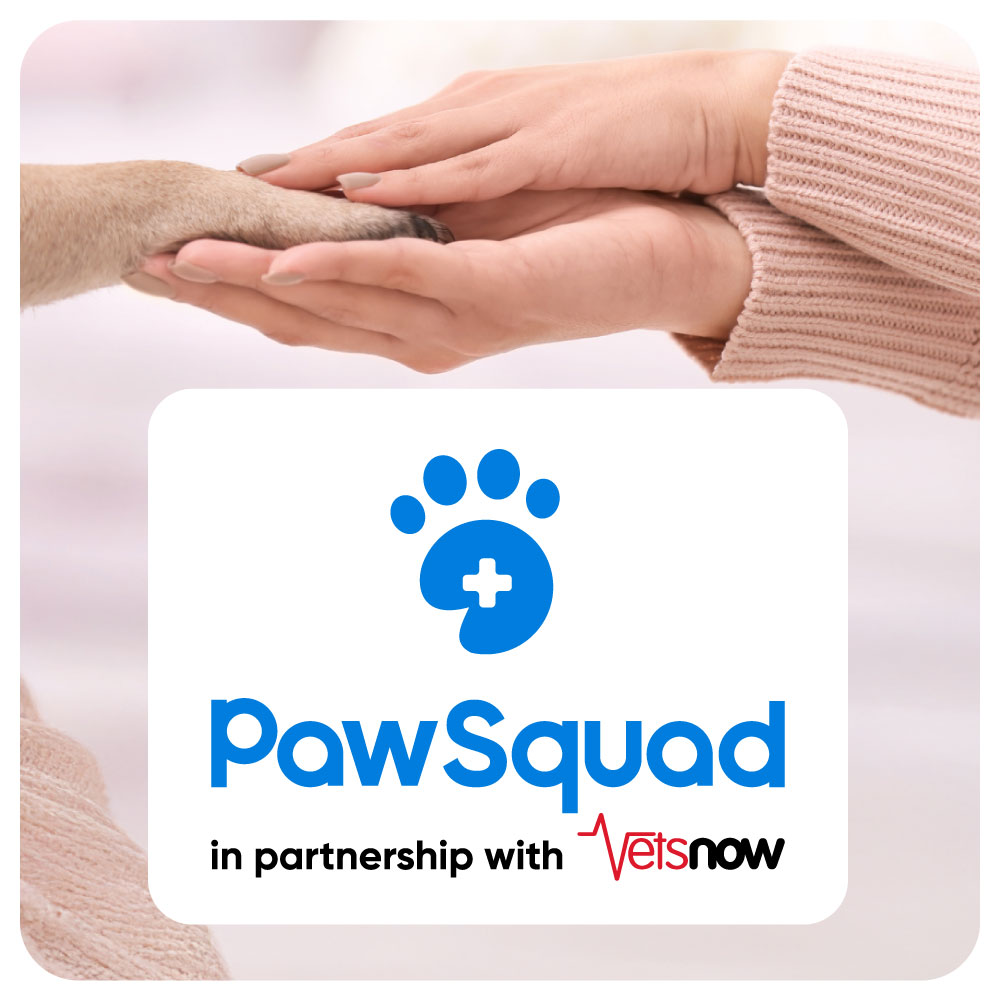- Breathing difficulties
- Deep or extensive wound injuries or significant bleeding (dripping)
- Prolonged seizure/fitting (more than 2 continuous minutes or more than 2 separate fits)
- Collapse
- Serious trauma (e.g. car accidents)
- Male cats struggling to pass urine or faeces
- Rabbits neglecting food
Online Vet Consultation In Minutes From Anywhere In The UK
Worried about your pet? Video chat with an online vet within minutes
Book an online video chat with one of our online vets and talk through your concerns from the comfort of your own home.
We're now working in partnership with telemedicine provider PawSquad, and here for you 24 hours a day, seven days a week.
*Pay-as-you-go vet consults £24. Prices may vary for specialist services.

How our online vet advice service works
-
Download the app
Consults start from £24 for a pay-as you-go video vet appointment. You can also subscribe for £8/month for unlimited online vet calls, for all pets in your household.*
If this is your first time, download the PawSquad app, choose a pet, pay or subscribe and choose your timeslot. Our consultations have no time limit (within reason!) so you can relax knowing that you have as much time as you need.*Fair usage terms
-
What will happen?
You explain your pet’s symptoms to our online vet, and they examine them by looking and listening to their symptoms on the screen. You can also upload any videos or photos that might help. The online vet will either offer advice on caring for your pet at home or, if it’s an emergency, they will help you arrange treatment. After your call, you’ll then receive a report from the vet.
-
Speak to a vet straight away
On your smartphone or tablet, download the app and register you and your pet/s. Then navigate to the ‘Speak to a Vet’ box and choose to start now. If you’re using a desktop computer or laptop, click here and register. Fill in a short form about your pet and use a credit or debit card to pay. Once you’ve registered, you will join the queue for the next available online video vet. 80% of calls are answered within 90 seconds.

Is an online vet consultation right for me?
If you’re worried about your pet and your regular vet is closed or it’s difficult to get there for any reason, we’re here for you. Our online vet can talk through your concerns and give you advice and peace of mind, or let you know if your pet needs to be seen at a clinic.
PawSquad also offers appointments with other veterinary healthcare professionals, including behaviourists and nutritionists.
You can use our Health and Happiness trackers throughout the year to build a picture of your pet’s wellbeing and flag anything that might be a trend worth investigation. You can also use PawSquad to arrange an arthritis and joint pain call that will give you a plan to help manage these conditions, and you can even arrange an online health check.
Please be aware that our vets are unable to prescribe medication via video consult.
What might be life-threatening:
Here are just some of the conditions our vets deem to be potentially life-threatening. In all of these cases, your pet may need urgent emergency treatment so please contact your registered vet or find your nearest Vets Now clinic immediately.
- Swallowing hazards i.e. toys/ clothes etc
- Ingestion of toxic/harmful substances
- Eye problems
- Severe vomiting or diarrhoea especially if your pet appears quiet or depressed or if it is going on for a long time (more than 24 hours)
- Swollen abdomen or retching (especially large dogs)
- Struggling to give birth
FAQs
- How long will my appointment last?
Video consults have not time limit, within reason! So, you have as much time as you need to discuss your case and share any relevant photos and videos.
- What equipment do I need?
PawSquad works on a mobile, laptop, desktop or tablet. We always suggest you download the app on your phone, then we’re instantly there for you should you want to quickly ask us for some advice.
The vet will want to see your pet and talk with you face-to-face, so it is best to sit with your pet in a well-lit area with little background noise. You will also need a decent internet connection.
You will also need access to the email address and mobile phone that you provided when you booked your appointment, so that the vet can contact you if there are any technical problems with your video link.- What should I do if I can’t access my appointment?
If you have technical difficulties and the connection is lost, the system will refund you if you’ve paid.
To avoid connectivity problems, we recommend using our app over the web platform.
If you don’t have access to a smartphone we recommend using:
• Google Chrome or Firefox on an Android device
• Google Chrome, Firefox or Microsoft Edge on a desktop device
• Safari on an Apple device (iPad or Mac)- Who are the vets I'll be speaking with?
Our vets are all experienced clinicians with a wealth of knowledge in emergency medicine. All our vets have at least five years’ experience and are RCVS registered.
- Can I use PawSquad abroad?
The service is only available to UK residents. If you reside outside the UK, you should contact a veterinary surgeon in your own country who will be more familiar with local diseases and health problems.
- What symptoms can PawSquad help with?
We know that being a pet owner can sometimes be a worry. We’re here to answer any questions or concerns you may have. On most occasions, we can help you decide the right course of action for the health and wellbeing of your pet.
PawSquad is most suited to non-urgent queries. It can be used for general advice and guidance on whether you should be seen in clinic.
Here are some of the conditions our vets deem to be potentially life-threatening and are not suitable for PawSquad. In each case, your pet may need urgent emergency treatment so please contact your registered vet or out-of-hours care provider immediately.
- Breathing difficulties
- Deep or extensive wound injuries or significant bleeding (dripping)
- Seizing/fitting
- Collapse
- Trauma (e.g. car accidents)
- Male cats struggling to pass urine or faeces
- Rabbits neglecting food
- Any illness or injury in pets younger than 2 weeks old
- Swallowing hazards i.e. toys/ clothes etc
- Ingestion of toxic/harmful substances
- Eye problems
- Severe vomiting or diarrhoea, especially if your pet appears quiet or depressed or if it is going on for a long time (more than 24 hours)
- Swollen abdomen or retching (especially large dogs)
- Loss of thirst & appetite
- Struggling to give birth
- What animals can you help with?
The service is most appropriate for dogs, cats, domestic birds and small furries (such as guinea pigs, hamsters and rabbits). It is not recommended for exotic animals and we cannot provide video consultations for farm animals.
- How much does an appointment cost?
Consults start from £24 for a pay-as you-go video vet appointment. You can also subscribe for £8/month for unlimited online vet calls, for all pets in your household.
- How can I cancel an appointment?
If you would like to cancel or reschedule your appointment:
Access your account via app/web
Click on appointments
Select “start now” if its time
Select “cancel” or ” reschedule”
